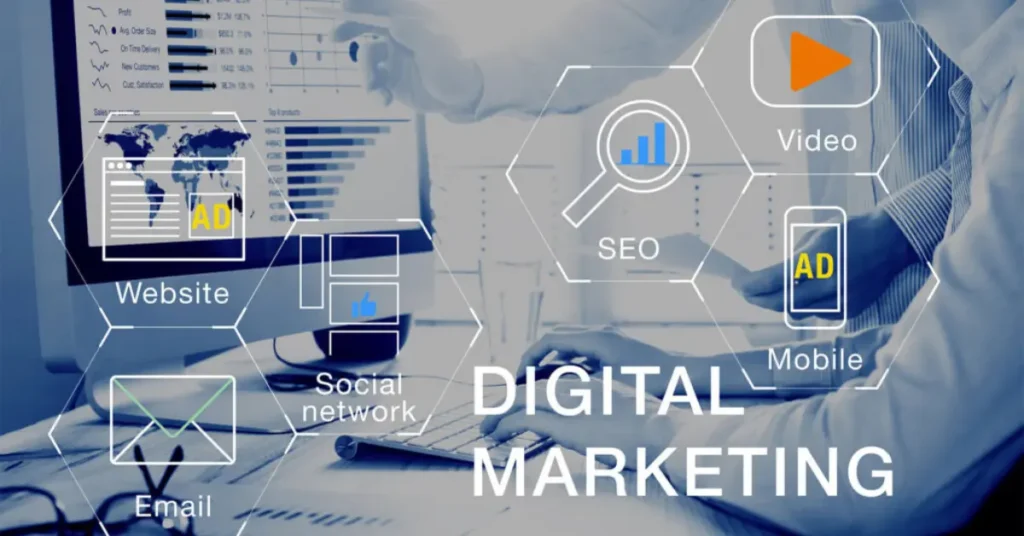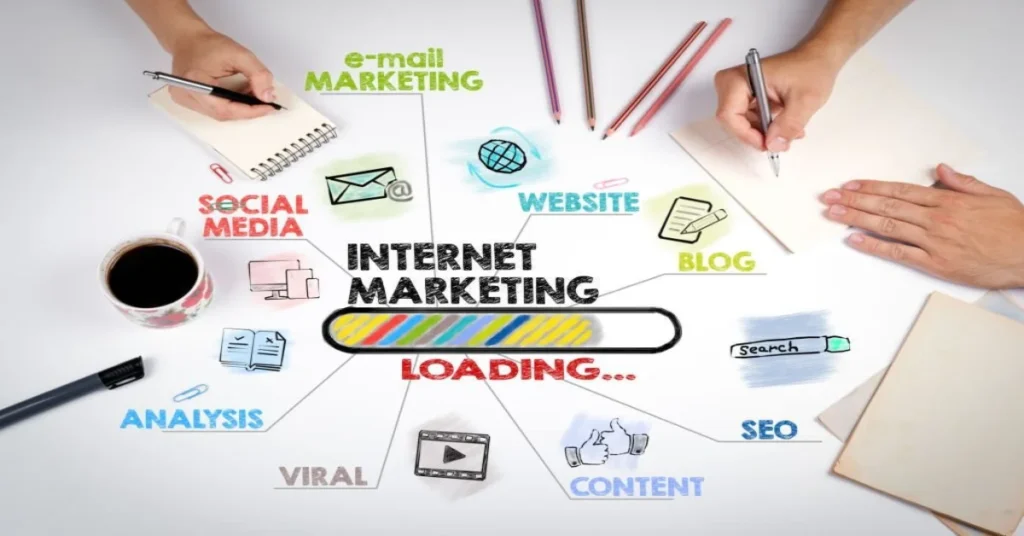Digital marketing ads are everywhere. They reach us on our phones, computers, and even smart TVs. I’m talking about the sponsored posts in your social feed, the ads before a YouTube video, and the results at the top of your Google searches. These ads enable businesses to connect with individuals seeking their products or services. They are essential for growth in today’s online world.
Why do these digital ads matter so much for businesses in the U.S.? Look around. Almost everyone is online, using smartphones, and shopping from their couches. Traditional ads simply don’t reach people as effectively as they used to. Digital ads offer a direct line to potential customers. They let businesses show their message to the right person, at the right time, and in the right place. This focused approach makes every advertising dollar work harder.
What Kinds of Digital Marketing Ads Can Businesses Use?

Many types of digital marketing ads exist. Each kind works best for different goals. Let’s look at the most common ones and where U.S. businesses use them.
Search Engine Ads (PPC)
When you search on Google, you often see ads at the very top. These are search engine ads, also called Pay-Per-Click (PPC) ads. Google Ads is the biggest platform for this in the U.S. Microsoft Advertising (for Bing) is also used.
- How they work: Businesses bid on keywords. When someone searches for that keyword, their ad can appear. They pay only when someone clicks their ad.
- Ad types: Simple text ads, shopping ads with product pictures, call-only ads, and local ads showing businesses nearby.
- Key facts: Good keyword choices are vital. Knowing what U.S. customers search for makes a big difference. Bidding strategies and ad quality also play a part.
Social Media Ads
Think about your Facebook, Instagram, or TikTok feed. You see ads mixed in with posts from friends. These are social media ads. Platforms like Meta (Facebook and Instagram), TikTok, LinkedIn, X (formerly Twitter), and Pinterest are popular.
- How they work: Businesses target people based on their interests, age, location, and what they do online.
- Ad types: Pictures, videos, carousels (multiple images), stories, reels, and lead forms.
- Key facts: Understanding U.S. social media trends helps. What kind of content do people on TikTok like versus LinkedIn? Your ad’s look and message should fit the platform.
Display Ads
These are the banner ads you see on websites. They can be static images or animated. Google Display Network (GDN) shows these ads on millions of websites. Programmatic advertising platforms also help businesses buy these ads.
- How they work: Ads show up on websites related to your audience’s interests or where your audience spends time.
- Ad types: Images, GIFs, interactive HTML5 banners.
- Key facts: Retargeting is powerful here. This means showing ads to people who have visited your website before. This reminds them of your product.
Video Advertising
Ads that play before, during, or after online videos are video ads. YouTube is a major player here. Social media platforms also have many video ad options. Connected TV (CTV) services like Roku and Hulu also show ads. As per Statista video ad spending from 2019- 2024 in the United States, Digital video advertising in the U.S. is experiencing robust growth, projected to reach $63.8 billion in 2024 and further increase to $72.4 billion in 2025, driven by strong performance in Connected TV (CTV), social video, and online video, as advertisers shift budgets from traditional media to capitalize on enhanced digital targeting.
U.S. digital video advertising is experiencing substantial growth, with spending projected to reach $72.4 billion in 2025, a 14% increase from $63.8 billion in 2024. This surge is driven by strong performance in Connected TV (CTV), social video, and online video, as advertisers shift budgets from linear TV to digital platforms for their enhanced targeting and programmatic capabilities.
- How they work: Businesses place ads on videos that their target audience watches.
- Ad types: Skippable ads (you can skip after a few seconds), non-skippable ads, short bumper ads, or ads that play outside of video players.
- Key facts: Tell a story quickly. Get your message across fast. Many U.S. households now stream TV, making CTV a growing place for ads. For example, Statista projects that U.S. CTV ad spending will reach nearly $30 billion by 2025.
According to eMarketer (Insider Intelligence) Digital ad spending forecasts, Digital advertising demonstrated strong growth in Q1 2025, driven by major platforms like Google, Meta, Amazon, and Microsoft reporting significant increases in ad revenue, fueled by advancements in AI, diverse ad formats, and robust user engagement, with retail media, paid search, and social media advertising leading the expansion.
Native Advertising
Native ads blend into the content around them. They often look like articles or other regular content on a website. You might see them on news sites. Taboola and Outbrain are common platforms.
- How they work: Ads match the style and feel of the website.
- Ad types: Sponsored articles, suggested content links.
- Key facts: These ads aim to build trust. They feel less like an interruption and more like helpful information.
Retail Media Networks (RMNs)
This is a fast-growing area, especially in the U.S. Think about Amazon. When you search for a product, you often see “Sponsored” results. These are ads on Retail Media Networks. Walmart Connect, Target Roundel, and Kroger Precision Marketing are other examples.
- How they work: Businesses advertise their products directly on retailer websites and apps.
- Ad types: Sponsored product listings, display ads on the retailer’s site, and even video ads.
- Key facts: These networks let businesses reach customers right when they are ready to buy. They use data from millions of shoppers. This helps them show the right ad to the right person at the very best moment. For instance, Insider Intelligence predicts U.S. retail media ad spending will exceed $60 billion by 2024.
Audio Advertising
Ads you hear on streaming music services or podcasts are audio ads. Spotify and Pandora are big platforms. Podcast advertising networks are also popular.
- How they work: Ads play during music or podcast episodes.
- Ad types: Short audio spots, often with a visual companion banner.
- Key facts: U.S. podcast listenership continues to grow. This offers a way to reach people while they exercise, commute, or relax. It’s a way to get your brand heard.
Many small business owners find the thought of digital advertising daunting, but it’s a powerful way to accelerate growth. If you are looking for broader strategies beyond just ads to expand your business, I have also shared a detailed guide on digital marketing for small business owners to power up your growth.
Building Strong Digital Marketing Ad Campaigns in the U.S.

Making digital marketing ads work means more than just putting them online. You need a plan.
Set Clear Goals and Track Them
First, decide what you want your ads to achieve. Do you want more people to know about your brand? Do you want more leads? Or do you want more sales?
- Goals: Brand awareness, lead generation, direct sales, customer loyalty.
- Trackers (KPIs):
- Impressions: How many times has your ad been seen?
- Clicks: How many times has someone clicked your ad?
- Click-Through Rate (CTR): Clicks divided by impressions (shows how appealing your ad is).
- Cost Per Click (CPC): How much each click costs.
- Conversions: How many people completed your desired action (e.g., bought something, filled out a form)?
- Return on Ad Spend (ROAS): How much revenue you get back for every dollar spent on ads.
Know Your U.S. Audience Deeply
Who are you trying to reach? This is the most important question.
- Who they are: Age, gender, where they live, what they earn, and their hobbies.
- What do they like? What motivates them? What problems do they need solved?
- U.S. differences: People in different parts of the U.S. might respond to different messages. For example, a business targeting people in Florida might use different images or language than one targeting people in Oregon. Think about how regional pride or specific cultural events could influence your message.
Manage Your Budget Wisely
How much will you spend? And how will you bid for ad space?
- Setting limits: Start with a budget you are comfortable with.
- Bidding types: You can pay per click (CPC), per thousand views (CPM), or per action (CPA).
- U.S. industry costs: Advertising costs can change a lot depending on your industry and location in the U.S. For example, advertising a local plumbing service in New York City might cost more per click than a national online clothing store. Researching average costs in your specific U.S. market helps you plan better.
Create Amazing Ads
Your ad copy (words) and creative (images/videos) make a huge difference.
- Visually appealing: Use high-quality pictures and videos. Make sure they match your brand.
- Clear message: Write headlines that grab attention. Your ad text should clearly state your offer. Always tell people what to do next (your Call-to-Action).
- Mobile first: Most U.S. internet use happens on phones. Make sure your ads look great and load fast on small screens.
- Test your ads: Don’t guess what works. Try different headlines, images, and offers. See which ones perform best with your U.S. audience. A small change in a headline can bring big results.
Optimize Your Landing Page
The page people go to after clicking your ad is crucial.
- Make it relevant: The landing page should directly relate to your ad.
- Make it fast: If it loads slowly, people will leave.
- Clear action: Make it easy for visitors to do what you want them to do (buy, sign up, call).
Navigating U.S. Laws for Digital Ads

Advertising in the U.S. means following certain rules. These rules protect consumers and ensure fair practices. Ignoring them can lead to big fines.
Federal Trade Commission (FTC) Guidelines
The FTC sets rules for honesty in advertising.
- Truthfulness: Your ads must be truthful. Don’t make claims you can’t back up.
- Endorsements: If someone reviews your product and gets paid, they must say so. This includes social media influencers.
- “Made in USA” claims: There are strict rules about when you can say a product is “Made in USA.”
Data Privacy Rules
This is a big one. How you collect and use customer data for ads is highly regulated in the U.S.
- California (CCPA/CPRA): California has strong privacy laws. Businesses must tell users what data they collect and let them opt out of data selling. Many businesses follow these rules for all U.S. customers now.
- Other states: States like Virginia, Colorado, Utah, and Connecticut also have their own privacy laws. These laws give consumers more control over their data. Always check the specific rules in the states where you advertise.
- Children’s Online Privacy Protection Act (COPPA): If your ads target children under 13, you have to follow strict rules about data collection. You usually need parental consent.
- HIPAA: If you advertise health-related services, you must be very careful with patient data. HIPAA protects health information. This impacts how you can use patient data for ad targeting.
Industry-Specific Rules
Some industries have extra rules for advertising.
- Alcohol and Tobacco: Strict rules on who you can target (age) and what content you can show.
- Medicine (Pharmaceuticals): The FDA has rules for drug ads. Ads must be balanced, showing both benefits and risks.
- Financial Services: Rules about advertising credit, loans, and interest rates to ensure fairness.
Political Advertising Rules
During election seasons, digital political ads have specific rules.
- Federal Election Commission (FEC): Requires disclosure for online political ads. You must say who paid for the ad.
- Platform rules: Google, Meta, and other platforms have their own rules for transparency in political advertising.
Accessibility (ADA Compliance) for Ads
Your digital ads should be usable by everyone, including people with disabilities.
- Examples: Use alt text for images (text descriptions for screen readers). Add captions to videos so deaf or hard-of-hearing people can understand them.
Getting Better Results: Measuring, Optimizing, and Growing Your Ads

Once your ads are running, you need to watch them closely.
Key Numbers and Analytics
Don’t just run ads and hope. Look at the numbers.
- Impressions, Reach, Frequency: How many times seen, how many unique people saw it, and how often they saw it.
- CTR, CPC, CPM: How engaging your ad is and how much it costs.
- Conversion Rate: What percentage of clicks turn into sales or leads?
- ROAS: The money you make for every dollar you spend on ads.
Understanding Ad Impact (Attribution)
It’s often not just one ad that leads to a sale. A customer might see a social media ad, then click a search ad later, and then buy. How do you give credit to each ad? This is called attribution.
- Models: Different ways to assign credit (e.g., last ad clicked gets all credit, or credit is split among all ads seen).
- Privacy challenges: New privacy features, like Apple’s iOS updates, make it harder to track users across different apps and websites. This means advertisers need new ways to understand which ads truly drive results. Many U.S. businesses are now focusing more on “first-party data” – information they collect directly from their customers – to help with this.
Making Your Ads Better (Optimization)
This is a continuous process of improvement.
- Test everything: Try different pictures, videos, headlines, and offers. See what gets the best response.
- Refine your audience: Are you reaching the right people? Can you narrow down your target?
- Adjust bids: Pay more for ads that bring better results. Pay less for ads that don’t.
- Improve landing pages: Make sure the page your ad links to is easy to use and converts visitors.
- Timing matters: Show ads when your audience is most likely to be online.
Growing Your Ad Efforts
When ads work well, you can scale them up.
- Increase budget: If an ad campaign brings profit, spend more on it.
- New places: Try advertising on new platforms where your audience spends time.
- Automation: Use tools that automatically adjust bids and budgets to get the best results.
The Future of Digital Marketing Ads in the U.S.

The world of digital ads is always changing. Here are some things I see coming.
AI in Ad Optimization
Artificial Intelligence (AI) is already helping.
- Smart bidding: AI helps platforms bid the right amount for ads, getting you more for your money.
- Predicting results: AI can guess which ads will work best.
- Creating ads: Soon, AI will help write ad copy and even design visuals. This will make ad creation faster and more efficient.
Privacy-First Advertising
With growing concerns about online privacy, the way we advertise is changing.
- No more cookies? Google is slowly getting rid of third-party cookies. These cookies track you across websites. This means advertisers need new ways to target people.
- Your data: Businesses will rely more on “first-party data” – information they gather directly from customers through their websites or apps. This data is private and controlled by the business.
- Privacy Sandbox: Google’s “Privacy Sandbox” is a new set of tools. It aims to let advertisers target groups of people without tracking individuals. This is a major shift for U.S. advertisers.
Generative AI for Ads
Imagine AI writing many versions of an ad for you in seconds.
- Fast creative: AI can quickly create ad copy, headlines, and even images or short videos. This saves time and helps businesses test many ad ideas.
Hyper-Personalization
Ads will become even more tailored to each person.
- Dynamic ads: Ads will change based on what a specific person is interested in, or what they recently looked at online. It will feel like the ad was made just for them.
The Rise of Influencer Marketing
Influencers on social media are becoming a big part of ad campaigns.
- Authenticity: Businesses partner with influencers whose followers trust them. This can make ads feel more real.
- FTC rules: Remember, influencers in the U.S. must clearly state if they are paid for a post.





